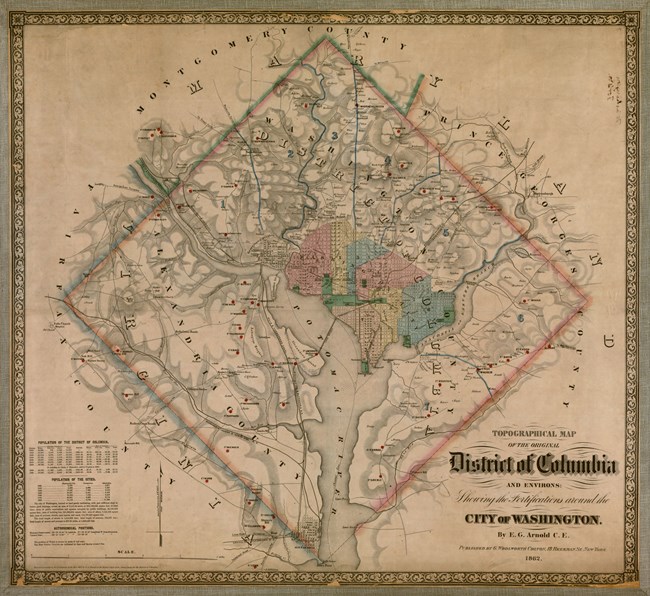
Library of Congress The defense of Washington evolved over time. The first iteration occurred months prior to armed hostilities and involved uniformed soldiers as the frontline barriers. These men, a mix of Regulary Army troops and local militia, were tasked with defending government property and ensuring the peaceful inauguration of president-elect Abraham Lincoln in March 1861. The show of force worked. Abraham Lincoln was inaugurated as the 16th President of the United States on the steps of the unfinished but secured Capitol building on March 4, 1861.The inauguration had come and gone but the fear for the Capital's safety continued due to military reverses nearby and the lack of troops in the city. Fort Sumter, in Charleston Harbor, surrendered on April 14, 1861. The burned-out Harpers Ferry armory fell to the rebels on April 19, and the Confederates occupied the destroyed Gosport Navy Yard on April 21. In addition, riots broke out in Baltimore on April 19, 1861, between pro-Confederate and pro-Union citizens. Among other results, the riots cut-off railroad communication with the North. President Lincoln, on April 1, 1861, had requested Winfield Scott to inform him daily of the military situation throughout the country and the news was not pleasant. On April 15, Lincoln declared that "an insurrection existed," called for seventy-five thousand troops and convened Congress in a special session to begin on July 4. The call for troops caused bad feeling in some southern-leaning states such as Missouri, Kentucky, Maryland, North Carolina and Virginia. The Virginia State Convention passed "an ordinance of secession" and ordered a May 23 public referendum on it. The Army countered by creating the Department of Washington, encompassing the District of Columbia and the State of Maryland, under the command of Brevet Colonel Charles F. Smith. The timely arrive of Federal reinforcements temporarily secured the capital, but the army was required to seize the initiative to ensure its possession in the United States. Attention turned to Virginia where Confederate flags were visible from highpoints in Washington, rebel troops' campfires blazed at night, and the citizenry would vote on secession soon, on May 23. Given the large number of troops now in Washington, only a few feared these events in Virginia. Colonel J.F.K. Mansfield, the then commander of the Department of Washington, however, argued for the occupation of Northern Virginia to preclude the possibility of rebels mounting artillery on its heights and shelling government buildings in the capital. He also urged the occupation of Alexandria to insure navigation on the Potomac River and the erection of fortifications on the Virginia side to protect the southern terminus of the Chain and Long Bridges and the Aqueduct. His superiors approved these recommendations but implementation was delayed until after the Virginia citizenry's popular referendum on secession. On May 23, 1861, the public referendum in the State of Virginia held on the Ordinance of Secession was three to one in favor of leaving the Union. Many in Washington had been sure that the vote would go that way but waited to make sure before launching a military force into Northern Virginia. After months of non-activity in the area, military movements began. According to Brigadier General Irvin McDowell, commanding Federal occupational forces in Virignia, "defensive works [were] under construction." |
Last updated: August 27, 2020
